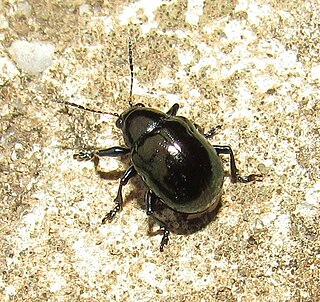
Colasposoma is a genus of leaf beetles in the subfamily Eumolpinae. It is known from Africa, Asia and Australia.

Colaspis is a genus of leaf beetles in the subfamily Eumolpinae. It is one of the largest genera in the subfamily, containing over 200 species, and it is known from both North and South America. A number of species from this genus are considered to be pests, such as the grape colaspis. Some species are known from the fossil record from the Eocene of Colorado in the United States.
Colaspoides is a genus of leaf beetles in the subfamily Eumolpinae. It is one of the largest genera in the subfamily, containing over 260 species worldwide. It is an extant genus but there is at least one species, C. eocenicus, found in Baltic amber from the Upper Eocene of Russia, and the genus has also been reported from the Miocene of the Dominican Republic.

Brachypnoea is a genus of leaf beetles in the subfamily Eumolpinae. It is mostly found in the Neotropical realm, though there are also eight known species in the Nearctic realm.

Eumolpini is a tribe of leaf beetles in the subfamily Eumolpinae. It is the largest tribe in the subfamily, with approximately 170 genera found worldwide. Members of the tribe almost always have a longitudinal median groove on the pygidium, which possibly helps to keep the elytra locked at rest. They also generally have a subglabrous body, as well as appendiculate pretarsal claws.

Rhabdopterus is a genus of leaf beetles in the subfamily Eumolpinae. There are about 70 described species in Rhabdopterus from North and South America, eight of which are found north of Mexico. The Nearctic species may not be congeneric with the type species, which is South American.
Spintherophyta is a genus of leaf beetles in the subfamily Eumolpinae. Most species in the genus are found in Central and South America, but there are also a few North American species.

Colaspidea is a genus of leaf beetles in the subfamily Eumolpinae. It is known from North America and the Mediterranean. It has recently been suggested that the Mediterranean species of Colaspidea are a sister genus to Chalcosicya, and that Colaspina forms a sister genus to the former two combined. It has also been suggested that the North American species of Colaspidea may represent a separate genus.

Typophorus is a genus of leaf beetles in the subfamily Eumolpinae. There are at least 52 described species in Typophorus. Similar genera include Paria and Tijucana. Typophorus itself is probably polyphyletic.

Typophorini is a tribe of leaf beetles in the subfamily Eumolpinae. The tribe contains approximately 100 genera, which are found worldwide. Members of the tribe are mainly characterized by notches on the tibiae of the middle and hind legs, which are sometimes referred to as antenna cleaners. They also generally have a subglabrous body, as well as bifid pretarsal claws.

Chrysochus is a genus of leaf beetles in the subfamily Eumolpinae. It is known from North America, Europe and Asia.
Prionodera is a genus of leaf beetles in the subfamily Eumolpinae. It is known from Central and South America.
Metaxyonycha is a genus of leaf beetles in the subfamily Eumolpinae.
Allocolaspis is a genus of leaf beetles in the subfamily Eumolpinae.
Callicolaspis is a genus of leaf beetles in the subfamily Eumolpinae. It is known from South America. It was formerly considered a synonym of Lycaste Gistel, 1848, but in 2003 it was restored as a separate genus. Lycaste itself was later found to be an unnecessary replacement name for Chalcophana, and the name Eupetale was established for the species formerly placed under Lycaste.
Jansonius is a genus of leaf beetles in the subfamily Eumolpinae. It is found in Chile and Argentina. It was formerly placed in the tribe Adoxini, section Myochroites, but is now placed in Nodinini, section Metachromites.

Nodocolaspis is a genus of leaf beetles in the subfamily Eumolpinae. It is known from Central America and South America. The genus was first established by the Czech entomologist Jan Bechyné in 1949, as a relative of Nodonota containing species formerly placed in Colaspis.
Chalcoplacis is a genus of leaf beetles in the subfamily Eumolpinae. It is distributed in South America.
Guyanica is a genus of leaf beetles in the subfamily Eumolpinae.








